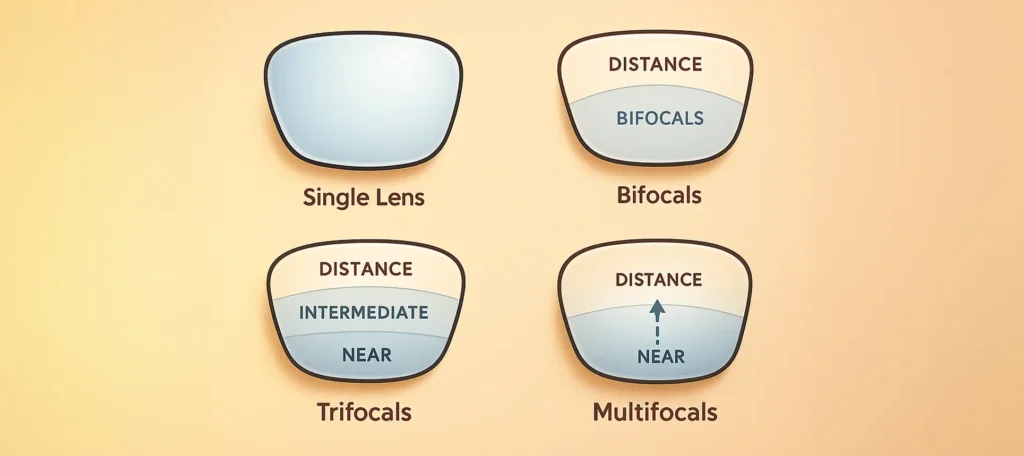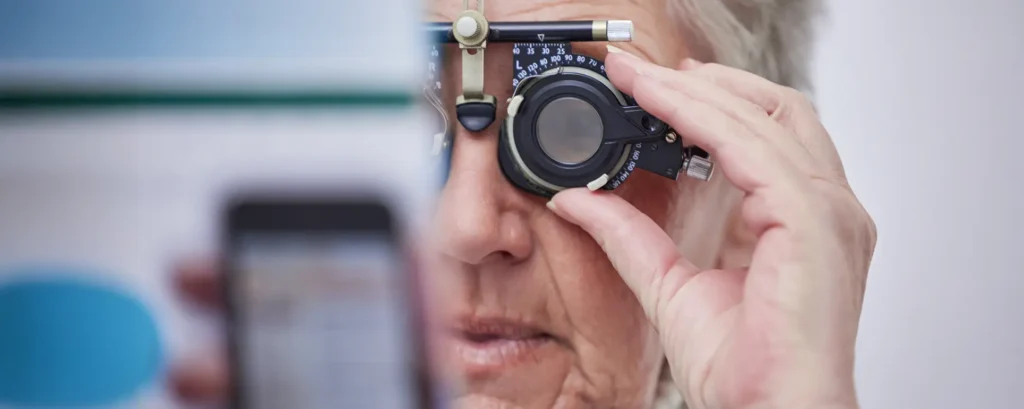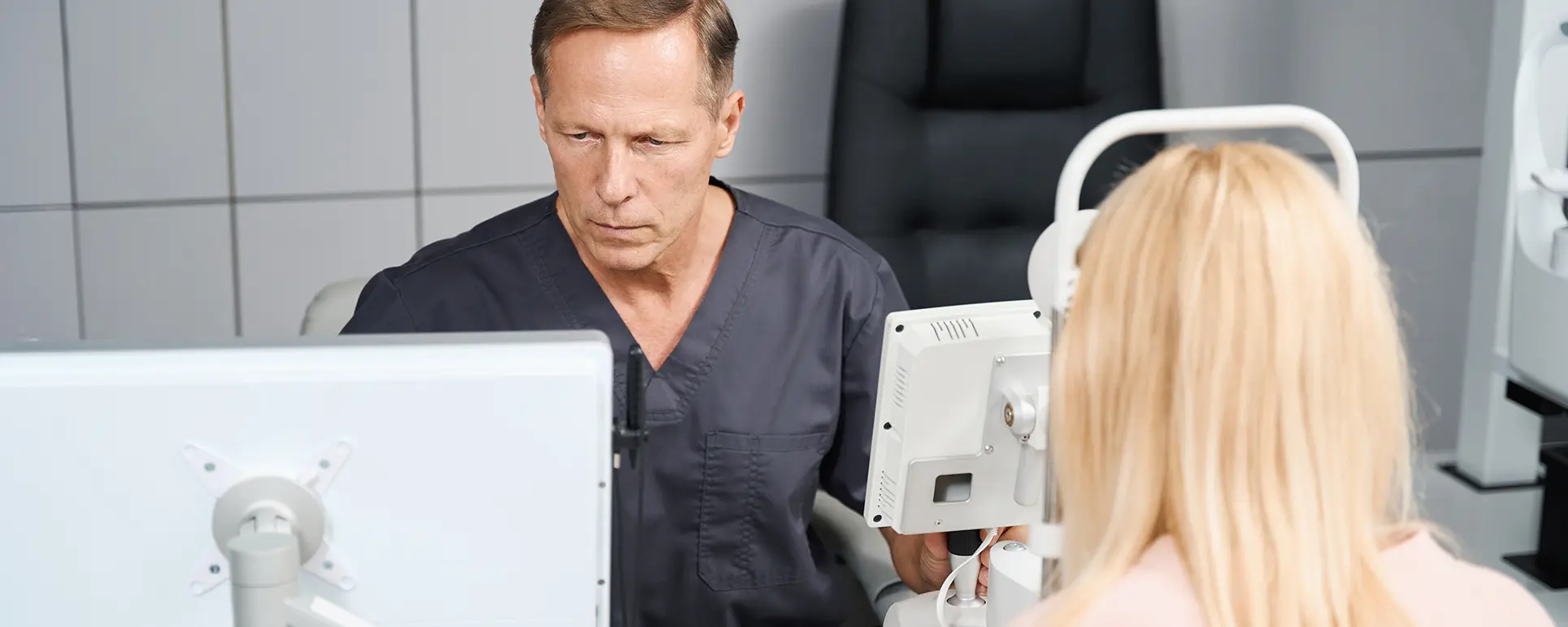If you’ve had cataract surgery or refractive lens exchange with a monofocal IOL, you probably expected great distance vision and, in most cases, that’s exactly what you get. But many people later realise they’d prefer more visual freedom, especially when it comes to reading menus, using their phone or working at a computer. Monofocal lenses provide excellent clarity at a single distance, but they don’t give the full spectacle independence that modern multifocal and extended-depth-of-focus (EDOF) lenses can offer.
You’re definitely not alone if you now want to reduce your dependence on glasses. I’ve met many people who originally chose a monofocal IOL believing it was the simplest or safest option, only to find later that their lifestyle would benefit from a broader range of focus. The good news is that you are not “stuck” with your monofocal lens. There are several ways to achieve multifocal-style vision and some of these don’t even require replacing your existing IOL.
In this article, I’ll guide you through all the safe and effective options available, explain who is suitable for each one and help you understand what results you can realistically expect.
Why a Monofocal IOL May Feel Limiting
A monofocal lens gives sharp focus at one distance usually set for far vision.
This means:
- Distance vision is crisp
- Near vision requires reading glasses
- Intermediate tasks may still need correction
- Fine details like labels, menus or phone text are harder to see
For many people, this is perfectly acceptable. But if you enjoy reading, cooking, DIY, photography, office work or digital devices, you may find yourself wanting more independence.
Monofocal lenses perform extremely well, but they don’t mimic the flexibility of a natural youthful lens something multifocal and EDOF lenses are designed to replicate.
Can You Get Multifocal Vision After Having a Monofocal IOL?

Yes, and you have several safe pathways to achieve it. Which option is right for you depends on:
- Your eye health
- The clarity of your capsule
- The position and power of your existing IOL
- Your corneal shape
- Whether you’ve had a YAG capsulotomy
- Your visual priorities
- Your tolerance for micro-disturbances in night vision
Let’s explore each option in detail.
Option 1: IOL Exchange to a Multifocal or EDOF Lens
This is the most direct method if you want true multifocal capability.
An IOL exchange involves removing the monofocal lens and replacing it with:
- A Multifocal IOL
- An Extended Depth of Focus (EDOF) IOL
- A Trifocal IOL
- A Multifocal Toric IOL (if you have astigmatism)
Best for:
- People who want maximum spectacle independence
- Patients unhappy with their monofocal clarity or range
- Individuals with minimal ocular surface issues
- Those who have NOT yet had YAG laser treatment
Benefits:
- Provides full multifocal vision
- Range of focus improves significantly
- Ideal for people wanting to stop using reading glasses
Important considerations:
- The surgery is more delicate than the first one
- There is a higher risk if YAG laser has already been done
- Not everyone adapts well to multifocal optics
- Lens selection must be personalised
If your capsule is healthy and the existing monofocal lens isn’t the best match for your needs, IOL exchange is a strong option.
Option 2: Piggyback IOL (Add-On Lens)
A piggyback lens is an additional implant placed in front of your existing monofocal IOL, sitting in the ciliary sulcus.
This option avoids removing your current lens, making it less invasive than an exchange.
Types of piggyback lenses:
- Multifocal add-on
- EDOF add-on
- Trifocal add-on
- Toric add-on for astigmatism
Best for:
- Patients who still have a clear and healthy capsule
- Those not suited for IOL exchange
- Eyes where the primary IOL is well positioned
- Patients wanting a reversible option
Benefits:
- Adjustable and removable
- Less risk than full IOL exchange
- Offers multifocal-style vision
- Excellent for enhancing intermediate and near tasks
Limitations:
- Not suitable for all eye anatomies
- Requires precise sizing
- Slightly increased risk of inflammation or angle issues
Piggyback IOLs are becoming increasingly popular because they balance safety with flexibility.
Option 3: Laser Enhancement With Monovision or Blended Vision
If your monofocal IOL works well for distance, you may not need a full multifocal solution. Instead, you can achieve near and intermediate vision by adjusting one eye with laser surgery, such as PRK or LASIK.
Types of laser options include:
- Full monovision
- Micro-monovision
- Blended vision
How it works:
One eye remains focused for distance, and the other eye is adjusted to handle near or intermediate tasks.
Best for:
- Patients who want a conservative approach
- Those who want to avoid further surgery inside the eye
- People with healthy corneas
- Individuals wanting a quick recovery
Benefits:
- No lens replacement
- Highly precise
- Adjustable depending on your needs
- Good for reading and computer work
Things to consider:
- Some people need time to adapt
- Depth perception can change slightly
- Not ideal for high-demand night drivers
Laser enhancement is one of the easiest ways to expand your range of vision after receiving a monofocal IOL.
Option 4: Adjusting the Non-Dominant Eye Only
If you only need better close vision, adjusting the non-dominant eye may give the blend you want without dramatically changing your vision.
This could involve:
- PRK
- LASIK
- A small piggyback IOL
- A low-add multifocal IOL
Best for:
- People wanting subtle improvement
- Those who value precision distance vision
- Patients sensitive to optical side effects
You maintain distance clarity in your dominant eye but gain functional near vision in the other giving a natural multifocal feel.
Option 5: Using EDOF Add-On Lenses for a Natural Range of Focus

Extended depth-of-focus technology gives continuous clarity from distance into intermediate range. Reading glasses may still be needed for fine print, but daily tasks become far easier.
EDOF add-ons are excellent for:
- Driving
- Computer work
- Cooking
- Shopping
- Social activities
These lenses have fewer night-vision disturbances compared with classic multifocal designs.
Option 6: Light-Adjustable Lens Upgrade (If Suitable)
For patients wanting the most precise visual outcome and completely personalised optics, the light-adjustable lens (LAL) is a powerful option usually achieved through an IOL exchange.
The lens can be adjusted after surgery using specialised light treatments, giving excellent accuracy.
This is a strong choice if:
- You want total fine-tuning
- You have high visual expectations
- You’ve experienced refractive error after monofocal IOLs
- You want more predictability in your outcome
Which Option Is Safest for You?
The safest option depends on several factors.
1. Has YAG laser been done?
If yes → Piggyback lenses or laser enhancement are usually safer.
If no → IOL exchange remains possible.
2. What is your eye anatomy?
Factors include:
- Capsule stability
- Angle depth
- Corneal shape
- Dry-eye condition
- Axial length
Each option requires different anatomical considerations.
3. What are your visual goals?
Do you want:
- Full near, intermediate and distance clarity (trifocal)?
- A smooth, natural range (EDOF)?
- Better reading with minimal side effects (micro-monovision)?
Your goals help determine the best pathway.
4. How sensitive are you to halos or glare?
If you already notice halos at night, some multifocal IOLs may not be ideal.
EDOF lenses or blended vision may suit you better.
The Evaluation Process: What to Expect
Before deciding on your upgrade, expect a detailed assessment.
This includes:
- Full biometry
- Corneal topography
- Pupil measurements
- Ocular surface evaluation
- Macular OCT scan
- Dominance testing
- Visual lifestyle assessment
Your surgeon uses this information to identify which option will offer the best clarity with the lowest risk.
How Each Procedure Works
Let’s break down what each approach looks like.
IOL Exchange Procedure
- Similar to cataract surgery
- Monofocal lens removed
- New multifocal or EDOF lens inserted
- Performed under local anaesthetic
- Recovery takes a few days to weeks
- Excellent long-term clarity when done correctly
Piggyback Lens Procedure
- Small incision
- Add-on multifocal or EDOF lens inserted in front of your monofocal
- Less invasive than full exchange
- Reversible if needed
- Fast recovery
Laser Enhancement Procedure
- PRK or LASIK performed on corneal surface
- Takes minutes
- Improves near/intermediate range through blended vision
- Quick recovery
- Zero risk to the existing IOL
Outcomes You Can Expect
IOL Exchange
- Maximum range of vision
- Reduced glasses dependence
- Night halos possible depending on lens type
Piggyback Lens
- Excellent reading and intermediate boost
- Reversible
- Fewer disruptions compared to direct exchange
Laser Monovision / Blended Vision
- Natural-feeling range
- Minimal invasive risk
- Small adjustment period needed
Piggyback Risks:
- Angle crowding
- Lens rotation
- Interlenticular opacification (rare)
Laser Enhancement Risks:
- Dry eyes
- Glare in early healing stage
- Over- or under-correction (very rare)
Your surgeon will tailor the decision to your safety profile.
FAQs:
1. Can I really upgrade my monofocal IOL to get multifocal-type vision?
Yes, you absolutely can. Many people assume that once a monofocal IOL is placed, the visual outcome is permanent, but several safe upgrade options exist. Depending on your eye health and previous treatments, you may be suitable for an IOL exchange, a piggyback lens, blended vision with laser, or an EDOF add-on. The best approach is chosen after a full eye assessment that considers your capsule clarity, corneal shape, and whether a YAG capsulotomy has been performed.
2. Is an IOL exchange safe if I already had cataract or RLE surgery?
An IOL exchange is safe when done by an experienced surgeon, but it is more delicate than your first lens surgery. If your eye anatomy is stable and no YAG laser has been done yet, removing the monofocal lens and replacing it with a trifocal or EDOF design is very effective. The main considerations are slightly higher surgical precision requirements and the need for excellent pre-operative calculations. Most patients who undergo exchange enjoy a significantly expanded range of vision afterward.
3. What if I already had a YAG capsulotomy can I still upgrade?
Yes, but the options change. Once YAG laser has been done, the capsule behind the lens has an opening, which makes IOL removal riskier. In this situation, surgeons prefer alternatives such as piggyback add-on lenses or corneal laser adjustments, both of which avoid disturbing the existing implant. These methods still deliver excellent multifocal-style results while keeping the internal eye structures safe.
4. Will a piggyback IOL give me the same effect as a multifocal lens?
A piggyback IOL can closely mimic the effect of a multifocal or EDOF lens without removing the original monofocal implant. The add-on lens sits in front of the existing lens, providing additional focal points for near or intermediate vision. Many patients achieve reading and computer clarity with this approach, and because the add-on can be removed or exchanged later, it offers flexibility. It may not match the full power of a built-in trifocal lens, but it delivers substantial freedom from glasses.
5. Is laser monovision or blended vision a good alternative to lens surgery?
Laser enhancement is an excellent alternative for people who want improved near or intermediate vision without undergoing another internal eye procedure. The surgeon adjusts one eye to a slightly different focal point, allowing the two eyes to work together to give a natural range of focus. Most people adapt very quickly and appreciate the convenience, though a short adaptation period is normal. It is particularly useful when the monofocal lens already gives excellent distance clarity.
6. Will I have halos or glare after switching to a multifocal-style solution?
This depends on the option chosen and your individual sensitivity. Multifocal and trifocal lenses can introduce mild halos in night conditions, which many people adapt to within weeks. EDOF lenses generally produce fewer disturbances and feel more natural. Laser monovision often results in minimal night-time visual changes. If night driving is a major part of your lifestyle, your surgeon will guide you toward an option with fewer optical side effects.
7. How do I know whether a piggyback lens or an IOL exchange is better for me?
The decision relies heavily on the condition of your capsule, the position of your monofocal lens, and the presence or absence of YAG treatment. If the capsule is clear and stable and no YAG has been done, an IOL exchange may be the best way to achieve full trifocal capability. If safety is a concern or your monofocal lens is well positioned, a piggyback lens may offer a safer, reversible upgrade. A thorough examination determines the safest, most effective pathway.
8. What results can I realistically expect after upgrading?
Most patients gain significantly more freedom from glasses, especially for daily tasks such as reading a phone, working at a computer, cooking, or shopping. Those who choose trifocal or EDOF lenses often enjoy a wide continuous range of focus. Piggyback lenses provide a strong improvement for near and intermediate tasks. Laser enhancement delivers natural blended vision suitable for most daily needs. Your exact result depends on your eye health and the option selected, but the majority experience a noticeable improvement.
9. How long is the recovery time after each type of enhancement?
Recovery varies by procedure. IOL exchange usually follows a similar timeline to cataract surgery where vision improves over several days and continues to stabilise over a few weeks. Piggyback lenses often provide faster recovery because they do not involve removing the original lens. Laser procedures such as PRK or LASIK improve vision within days, with blended vision becoming more comfortable as your eyes adapt. Your surgeon will outline what to expect based on your chosen approach.
10. How do surgeons decide which option is safest for each person?
The decision is based on a careful evaluation that includes corneal scans, capsule stability, macular health, ocular surface testing, pupil measurements, dominance testing, and lifestyle assessment. Your tolerance for visual disturbances, your night-vision demands, and your desire for full spectacle independence also guide the recommendation. The goal is always to match your expectations with the safest and most predictable upgrade method so you achieve the best possible visual freedom.
Final Thoughts: Choosing the Safest Path to Multifocal Vision After a Monofocal IOL
Upgrading your vision after receiving a monofocal IOL is far more achievable than most people realise. Whether you want clearer near vision, sharper intermediate focus for computer work, or a fuller range without relying on glasses, there are several safe and effective options to choose from. The right pathway depends on your capsule clarity, whether you’ve had YAG treatment, your corneal health, and of course, the type of visual freedom you want in daily life.
Modern techniques from trifocal and EDOF IOL exchange to reversible piggyback lenses and precise laser-based blended vision allow your surgeon to match the solution to your unique anatomy and lifestyle. Each method has its strengths, and the goal is always the same: to give you greater independence with the lowest possible risk. If you’re thinking about IOL replacement surgery in London, feel free to contact us at the London Cataract Centre. Our team can guide you through your options and arrange a thorough assessment tailored to your eyes.
References:
1. Kim, D. Y., Woo, S. J., & Kim, Y. (2025) ‘Comparative Outcomes of the Next-Generation Extended-Depth-of-Focus Intraocular Lens’, Journal of Clinical Medicine, 14(14), p. 4967. https://www.mdpi.com/2077-0383/14/14/4967
2. Sánchez-González, J. M., Díaz-Doutón, F., & Alió, J. L. (2022) ‘Small Aperture IC-8 Extended-Depth-of-Focus Intraocular Lenses: Clinical Outcomes and Patient Satisfaction’, Journal of Clinical Medicine, 11(16), p. 4654. https://www.mdpi.com/2077-0383/11/16/4654
3. Patel, V., Pakravan, P., Lai, J., Watane, A., Mehra, D., Eatz, T. A., Patel, N., Yannuzzi, N. A. & Sridhar, J. (2023) ‘Intraocular Lens Exchange: Indications, Comparative Outcomes by Technique, and Complications’, Clinical Ophthalmology, 17, pp. 941–951. https://pubmed.ncbi.nlm.nih.gov/36993987/
4. Karjou, M., Sedaghat, M., & Sadeghi, R. (2021) ‘Secondary Piggyback Intraocular Lens for Management of Residual Ametropia after Cataract Surgery’, Journal of Ophthalmology, (prospective interventional case series) https://pubmed.ncbi.nlm.nih.gov/33520123/
5. Joshaghani, M., Soleimani, M., Foroutan, A. & Yaseri, M. (2015) ‘Visual Outcomes and Complications of Piggyback Intraocular Lens Implantation Compared to Aphakia for Infantile Cataract’, Middle East African Journal of Ophthalmology, 22(4), pp. 495–501. https://pmc.ncbi.nlm.nih.gov/articles/PMC4660539/

